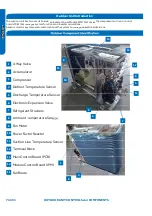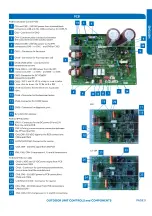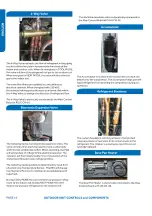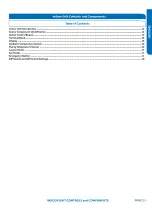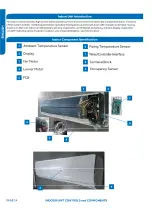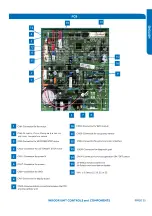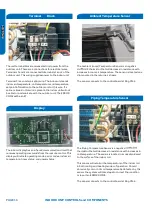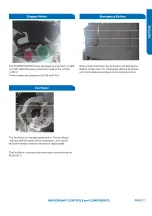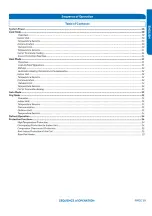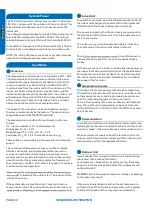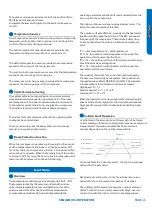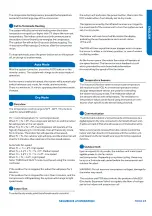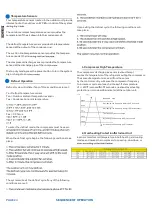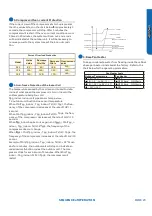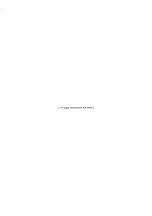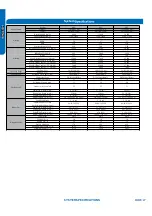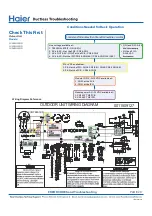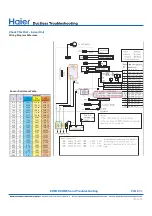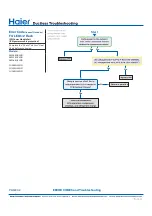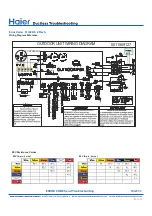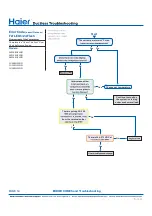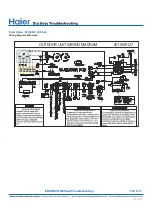
SEQUENCE of OPERATION
PAGE 21
The outdoor unit main board also controls the position of the
EEV (Electronic Expansion Valve)
to regulate the ow of refrigerant to the indoor unit evapora-
tor coil.
Temperature Sensors
Call to Terminate Cooling
●
The system will terminate cooling when the indoor ambient
temperature sensor is equal to or lower than 2°F of the room
set temperature. The indoor control board will communicate
to the outdoor control board to de-energize the compressor.
The outdoor fan will run for 60 seconds before stopping.
The indoor fan motor and louver will continue operating after
cooling has been terminated.
To stop cool mode, press the power button to turn the sys-
tem o , or change to another mode.
Freeze Protection Function
Heat Mode
●
Overview
The temperature control r
●
ange in heating mode is 60°F - 86°F.
The temperature set by the
●
remote control and the indoor
unit ambient temperature sensor will determine if a call for
heat is needed. If a call for he
●
at is justi ed, a temperature
compensation adjustment is automatically added to the
operating parameter and the call is communicated from the
indoor unit to the outdoor unit.
The indoor unit louver will open using a stepper motor. The
indoor fan will not operate at this time.
The outdoor unit will shift the 4-way valve to the heat mode
position and determine the position of the EEV and speed
(frequency) of the compressor. There can be a delay of up
to 3 minutes before the outdoor unit fan and compressor
start.
(Tr = room temperature Ts = set temperature)
If T
Ts, the outdoor unit will operate and the indoor fan
operates in cold air prevention function
If Tr > Ts+, the outdoor unit turns o and the indoor fan oper-
ates at heat residue sending mode.
If Tr < Ts+, the outdoor unit will restart and the indoor fan
operates in cold air proof mode.
The speed of the indoor fan can be controlled manually by
the user or automatically by the system. The speed can be
changed between HIGH, MEDIUM, and LOW. The predeter-
minedconditions for automatic control are as follows:
High Speed: Tr < Ts
Medium Speed: Ts T
Ts + 4°F
Low Speed: Tr > Ts + 4°F
When the indoor fan is running in automatic mode when the
speed switches from high to low, the indoor fan will maintain
high speed for a period of 3 minutes before switching to low
speed.
Four temperature sensors located in the outdoor unit provide
temperature information to the outdoor unit main board for
control of the system during cool mode.
The outdoor ambient temperature sensor provides the
temperature of the air drawn into the condenser coil
The defrost temperature sensor provides the temperature
sensed at the output of the condenser coil.
The suction line temperature sensor provides the temperature
sensed at the incoming suction line pipe.
The compressor discharge sensor provides the temperature
sensed at the discharge pipe of the compressor.
Cold Air Proof Operation
At initial start of heat mode, indoor blower will not be turned
on immediately until indoor coil temperature senses a minimum
temperature. This period usually takes 30 seconds to 3
minutes depending on the outdoor temperature.
f
of
fan,
airflow
airflow
Heat start temp 1
Heat start temp
2
Heat start temp
3
Heat start temp
4
Set speed
Low speed
Light speed
Fan/off
Fan/off
Keep the high
speed. The fan
doesn’t stop
4 minutes after the indoor fan starts, the light or low speed
When the compressor operates continuously for 10 seconds
and the temperature of the indoor coil has been below 32°F
for 10 seconds, the compressor will stop. The indoor unit fan
will continue to operate. When the temperature of the indoor
coil rises to 45°F for more than 3 minutes the compressor will
restart and the system will continue functioning.
will swich to the set speed.
Residual heat sending: the indoor fan will operate on low
speed until the coil temperature reaches 73 degrees.
The outdoor unit temperature sensors: outdoor ambient,
defrost, suction line, and compressor discharge, used in
conjunction with the indoor coil and room temperature
Summary of Contents for AW09EH2VHD
Page 2: ... This page intentionally left blank ...
Page 4: ...Failure to follow any CAUTION may in some cases result in grave consequences ...
Page 6: ...PAGE 6 ...
Page 9: ...5VDC and 15VDC pulsing communication connection between the PCB and the IPM ...
Page 10: ......
Page 11: ......
Page 12: ......
Page 13: ......
Page 14: ......
Page 15: ...Connector for coil temperature sensor and room temperature sensor ...
Page 17: ......
Page 19: ......
Page 22: ......
Page 23: ......
Page 26: ...PAGE 32 ...
Page 50: ...Error Code E7 LED1 15 Flash Wiring Diagram Reference PAGE 50 ERROR CODES and Troubleshooting ...
Page 57: ...PAGE 57 Ambient Defrost and Pipe Sensor Tables Discharge Sensor Tables ...


